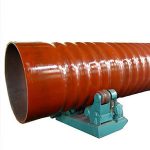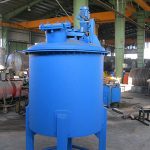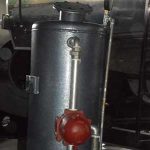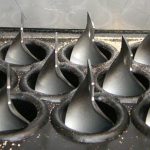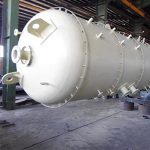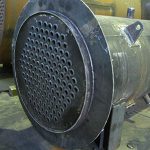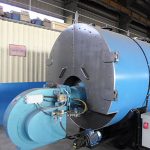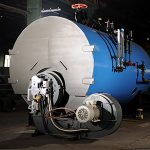CHP
CHP
CHP
هم اكنون با توجه به سياست های اقتصادی دولت به منظور هدفمند كردن يارانه ها و افزايش قيمت حامل های انرژی و از طرفی اهميت بيش از پيش هزينه سوخت در قيمت تمام شده كليه محصولات توليد داخل و همچنين حمايت وزارت نيرو از احداث واحد های توليد برق در مقياس كوچك توسط اشخاص حقيقی يا حقوقی موجب شده تا مديران صنايع نسبت به صرفه جويي بيشتر در مصرف انرژی اهتمام ورزيده و بعضاً اقدام به احداث نيروگاههای برق با مقياس كوچك نمايند.
در مجموعه ها مصرف كننده های عمده انرژی عبارتند از:
1- موتورهای احتراق داخلی
2- مشعلها
روشهای بهینه سازی انرژی مصرفی در مجموعه موتورها و مشعل ها:
۱- تنظیم فشار پمپ سوخت
۲- تمیز كردن و یا تعویض نازل پاشش سوخت
۳- تنظیم و كنترل مستمر هواكش و یا دمپر هوا و در صورت وجود تعویض بموقع فیلتر های هوا
رعایت نكات اساسی فوق باعث كاهش قابل توجه سوخت مصرفی میشود .
مبحث دیگری كه در اشل كشوری دارای اهمیت میباشد افزایش راندمان سیستمهای مصرف كننده سوخت میباشد . بطور مثال راندمان یك مشعل حدوداً 80 % است كه با تنظیم مقدار هوای مناسب و پا شش صحیح سوخت افزایش این راندمان تا 98 درصد امكان پذیر میباشد .كه باید سازمانهای گواهی دهنده و استاندارد در سطح كشور به آن توجه نمایند .
بعنوان مثال :
راندمان یك نیروگاه گازی حدود 31 % الی 36 % در شرایط ایده آل كار توربین ، كمپرسور،كوره هوای گرم می باشد الباقی انرژی كه حدوداً 64 % الی 69 % میباشد بصورت گازهای داغ از دودكش خارج میگردد كه با قراردادن مبدل آبگرم یا بخار و یا هوای گرم مقدار راندمان 31% الی 36 % را تا 70 % الی 78 % میتوان ارتقاء داد ، اگر درصد های فوق را به واحد های انرژی تبدیل كنیم مقدار صرفه جویی قابل لمس تر خواهد بود . بطورمثال در یك شهرك صنعتی كه بطور متوسط مجموع مصرف انرژی با راندمان 50 % میباشد . مصرف سوخت این شهرك صنعتی در روز معادل ده ماشین حمل سوخت با مجموع ظرفیت 000/280 لیتر میباشد .
انرژی حاصل از این سوخت مایع حدوداً 2800 مگا كیلوكالری میباشد . كه فقط 1400 مگا كیلوكالری آن بصورت مفید مصرف و الباقی بصورت حرارت از دودكش ها و بدنه ماشین آلات خارج میگردد و به ازای هر یك درصد افزایش راندمان 1400 لیتر صرفه جویی سوخت خواهیم داشت و اگر بتوانیم راندمان مجموعه را تا 70 % ارتقاء دهیم . یعنی 28000 لیترصرفه جویی در روز برای یک مجموعه.
مسئله صرفه جویی در كشورهای پیشرفته از قدمت بیشتری برخوردار میباشد شاید به قدمت اختراع دیگ بخار كه در آن زمان محوطه كارگران را با گرمای حاصل از دودكش گرم میكردند .
به دلیل اهمیت موضوع شاخه ای از علم مكانیك به این موضوع اختصاص داده شده است و آن تركیب حرارت و قدرت یا Combind Heat & Power یا اختصاراً CHP نامیده شده است .
علم CHP بدلیل صرفه جویی در سرانه انرژی مصرفی کشورها و کمک به پاکیزگی محیط زیست ودر بعضی از مواقع جلوگیری از الودگی هواو همینطور استفاده از انرژی پاك طبیعت پیشرفت قابل ملاحظه ای كرده است .
بطور مثال انسان مدرن با صرف هزینه های بسیار زیاد از گرما و انرژی خورشید توسط سلولهای خورشیدی انرژی دریافت میكند در حالیكه دهها برابر آنرا توسط اگزوزها و دودكش ها هدر می دهد . بنابراین به موازات استفاده از انرژی پاك استفاده از حرارت دودكش ها نیز به طبیعت كمك می كند .
حرارتی كه از دودكش میگیریم در كجا میتوان مصرف كرد؟
1- گرمایش محیط زندگی و كار
2- تولید بخار جهت مصارف صنعتی و یا نیروگاه بخار (سیكل تركیبی)
3- تولید آبگرم مصرفی ساختمانها و ادارات و كارخانجات
4- تولید كوره های هوا گرم
5- استفاده از هوای گرم جهت خشك كردن میوه جات
6- استفاده از حرارت دود و گازهای خروجی موتورهای درون سوزجهت ژنراتور دستگاههای Absorbtion برای تولید هوای سرد در تابستان .
7- دریافت انرژی الكتریسته ( برق ) از حرارت دودكش در نیمه هادی ها و ترموكوبلها ( اگر دو فلز با دو جنس مخالف را از یك سر بهم گره بزنیم و در مقابل حرارت قرار دهیم در دو سر دیگر اختلاف ولتاژ بوجود میاید كه این اختلاف ولتاژ بطور خطی افزایش می یابد. با سری كردن این ترموكوپلها می توان به ولتاژ های قابل قبول جهت روشنایی محوطه در شبها رسید .)
محدودیت های استفاده از هوای گرم دودكشها :
1- محدودیت دمای مبدل حرارتی
مبدلی که گرمای دودکش و محصولات احتراق را دریافت میکند خود سقف دمای كار از پیش تعیین شده ای دارد.این سقف محدودیت استفاده از دود را تعیین مینماید .
مثال : اگر قصد داریم دیگ بخاری با فشار کار 10 اتمسفر سر راه دودكش قرار دهیم ناچارا” دمای اشباع بخار 180 درجه خواهد بود و حداقل 20 الی 30 درجه سانتیگراد دمای دود خروجی از مبدل باید بالاتر باشد .بنابراین دود خروجی از مبدل و در نهایت دودكش به 230 درجه سانتی گراد محدود خواهد شد .
2- محدودیت نقطه شبنم :
هنگامیكه دمای دود به پایین تر از دمای نقطه شبنم می رسد بخار آب كندانس شده و با گوگرد و یا CO2 موجود در سوخت و دود ، اسیدی با PH پایین تولید مینماید كه موجب خوردگی در مبدل و یا دیواره دودكش میگردد و طراح باید در مقوله طراحی دمای دود را در نظر گرفته و به نسبت خورندگی گازها جنس دودکش را تعیین نماید.
3- افت فشار كوره :
مهمترین نكته در استفاده از مبدلهای CHP افت فشار كوره میباشد.
وقتی که افت فشار مسیر گازهای داغ افزایش میابد موجب هدر رفتن مقداری از قدرت الکتروموتور برای جبران این افت میگرددو ایراد اساسی که در فن مشعلها و یا كمپرسورها بوجود میا ید مقدار هوای طراحی شده است كه بشدت كاهش یافته و این كاهش هوا موجب بالا رفتن دمای شعله و یا دود شده وتولید گازهای NOX میگردد که به محیط زیست اسیب میرساند.
در این مورد بحثهای فراوانی پیش میاید که در جای خود بدان پرداخته خواهد شد .
مثلاً چرا از ابتدا راندمان را بالا نمی بریم ؟كه مجبور بشویم از ضایعات حرارت استفاده كنیم .
واقعیت این است كه در بسیاری از پروسه های عملی امكان بالا بردن مستقیم راندمان وجود ندارد .برای بالا بردن راندمان یك نیروگاه بخار بشكل ذیل عمل می شود .
1- افزایش دمای بخار ورودی توربین .
2- كاهش دمای آب ورودی پمپ .
حال اگر فرض كنیم تمامی تجهیزات نیروگاه شامل دیگ بخار – توربین – پمپ كندانسور با راندمان 100 % كار كنند راندمان ایده آل این نیروگاه برابر با :
( دمای بخار به كلوین ) / ( دمای آب به كلوین- دمای بخار به كلوین) = μ
بالاترین دمایی كه بخار را می توان افزایش داد 370 درجه سانتی گراد و یا 643 = 370 + 273 درجه كلوین و كمترین دمایی كه اقتصادی باشد دمای محیط می باشد . اگر در زمستان دمای کندانسور را تا 7 درجه سانتی گراد و یا 280 = 7 + 273 درجه كلوین پایین اورده شود بالاترین راندمان این نیروگاه در صورت داشتن راندمان 100% تك تك اجزای آن برابر با :
f2 <strong><span style=”font-family:bnazanin; font-size: 16pt;”>CHP</span></strong>
رسیدن به راندمان ایده آل نیاز به پمپی دارد كه 210 آتمسفر كار كندیا فلزی که در دمای بالا و فشار بالایی را تحمل نماید كه بسیار گران خواهد شد.پس در جاهایی که محدودیت قیمت و راندمان داریم راه دیگری باید انتخاب کنیم یکی از این راهها CHP میباشد .
تعريـف CHP :
به زبان ساده كنار آمدن با طبیعت و تلفیق استفاده از حرارت و قدرت در یك سیستم حرارتی را CHP می گوییم و برای هر فضا و مكان نحوه استفاده خاصی را می طلبد كه طراح باید آنرا ببیند .
با استفاده از تجربیات عینی ، مثالهای ملموسی برای طراحی بیان میشود :
1- استفاده از حرارت اگزوز بویلر جهت مجتمع های مسكونی :
الف ) دیگ بخار : از دود دیگ بخار می توان آبگرم مصرفی مجتمع و در تابستان آبگرم آبزوربشن را تامین نمود و یا در زمستان جهت آب كردن برف پشت بام استفاده كرد .
ب ) بویلر آبگرم : جهت آب كردن برف در زمستان و تامین قسمت اعظم آبگرم مصرفی مجتمع با قراردادن یك منبع ذخیره بزرگتر وتامین هوای گرم گلخانه مجتمع و حتی تولید بخار برای سونای یك مجتمع .
2- دیگ بخار صنعتی
الف ) با ظرفیت كمتر از 5 تن
تهیه آبگرم صنعتی و بهداشتی
تهیه هوای گرم تمیز برای گرم كردن محیط
پیش گرم کردن (اکونومایزر) آب ورودی دستگاه
ب ) با ظرفیت بیش از 5 تن
استفاده مشابه ردیفهای (1 ) به علاوه ایجاد یك بویلر آبگرم
افزایش دمای هوای ورودی بویلر
ج ) دیگ روغن داغ
استفاده جهت گرمایش محیط
در تابستان جهت خنك كاری امور اداری
ایجاد یك دیگ بخار كوچك
تولید هوای گرم برای مصارف خاص
د ) كوره هوای گرم
خـروجی های كــوره های هوای گــرم معمولاً دارای دمای بـالایی میبـاشند . زیرا در این دستـگاهها و دستگاههـای
روغنداغ به دلیل اینكه سیال عامل در دماهای بالایی مورد استفاده قرارمیگیرند به تبع دمای اگزوز نیز بالا خواهد بود
كه بشرح ذیل مورد بهره برداری قرار میگیرد .
استفاده جهت گرمایش محیط
در تابستان جهت خنك كاری امور اداری و جاهای مورد نیاز
تهیه آبگرم مصرفی كارخانه
تهیه بخار برای مصارف خاص (مثلاً اتو بخار )
تولید هوای گرم با دمای پایین جهت خشك كنها و …
پیش گرم كردن آب ورودی دیگهای بخار در صورت وجود
ایجاد آب شیرین كن برای مناطقی كه آب بهداشتی ندارند
كارخانجات غذایی برای خشك كردن مواد اولیه می توانند استفاده كنند .
نيروگـــاه بـــرق
بحث اصلی CHP بیشتر جهت نیروگاههای برق میباشد.. زیرا اخیراً ساخت نیروگاههای كوچك تا 25 مگاوات بسیار رواج پیدا كرده و دولت حاضر به خرید برق مازاد تولیدی این كارخانجات میباشد . اگر از انرژی هدر رفته این نیروگاهها استفاده نشوداین نیروگاهها غیر اقتصادی میشوند . در حال حاضر روشهایی که میتوان از انرژی ضایعاتی این نیروگاهها استفاده کرده از اهمیت زیادی برخوردار میباشند بنابراین لازم است تولید کننده برق پراکنده از انحاء موارد استفاده آگاه گردد.
نیروگاههای كوچك برق به 4 صورت اصلی هستند :
۱- توربین بخار
۲- توربین گاز
۳- موتور احتراق داخلی
۴- ترکیبی از توربین بخار و گاز
توربین بخار:
ابتدا آب با فشار زیاد به دیگ بخار پمپاز میگردد .در دیگ بخار اب تبخیر شده و دمای بخار به دمای بالاتر از دمای اشباع برده شده و سوپر هیت تولید میشود .بخارخشک حاصل وارد توربین شده و توسط ان محور یک ژنراتور برق به چرخش درآمده برق تولید میکند خروجی بخار توربین سپس وارد کندانسور شده و تقطیر میگرددو دوباره وارد سیکل پمپ میشود. در این نیروگاهها بهتر است از توربین های BACK PRESSUR استفاده کرد زیرا خروجی بخار این توربینها دارای فشار بوده و میتوانند یک کارخانه ای که به بخار فشار پایین نیاز دارد فرستاده شده و سپس خروجی تله بخار ها را جمع آوری و به پمپ برگردانده شود. این مبحث نکات بسیار ریز ودرشت داشته که در یک کتاب میتوان آنرا جمع آوری کرد.
توربین گاز:
توربین گاز همانند موتور یک هواپیمای جت میباشد. هوا ابتدا توسط کمپرسور تحت فشار واقع شده به داخل اتاق احتراق هدایت میشود گاز و یا سوخت وارد این اتاق شده با هواسوخته و گازهای داغ تولید میشود از انجا وارد یک توربین گاز شده و پره های انرا به حرکت در میاورد و وقتی از توربین خارج میشود دمایی حدود 600 الی 800 درجه سانتیگراد دارد .این هوای داغ بسیار پر انرژی و از مزایای آن کم بودن نسبت گاز دی اکسید کربن به اکسیزن میباشد و میتوان گفت گاز داغ اما پاک میباشد .
از معایب این نوع نیروگاه ها نیاز به گاز طبیعی بصورت فشرده ( كمپرس شده ) میباشد .
سیکل ترکیبی :
اگر گازهای خروجی توربین وارد مبدلی شود که بخار سوپر هیت تولید میکند و بخار سوپر هیت وارد توربین بخار گردد در آنصورت نیروگاه سیکل ترکیبی خواهد بود .
نیروگاه موتور درون سوز :
این نوع نیرو گاهها را میتوان اولین نیروگاه پراکنده نامید ، یک موتور احتراق داخلی با سوخت بنزین یا گازوییل و اخیرا گاز طبیعی محور یک ژنراتور را به گردش در آورده و برق تولید میکند. در دو نقطه از انرژی هدر رفته این موتور ها میتوان استفاده کرد اول استفاده از گرمای روغن موتور که توسط سیال آب گرفته میشود و دیگری استفاده از گازهای حاصل احتراق آن که دارای دمایی حدود 400 الی 600 درجه سانتیگراد میباشد .نکته مهم در موتور های احتراقی با گاز طبیعی در داغتر بودن دمای خروجی گازها نسبت به گازوییل میباشد .
راندمان این نیروگاهها عموما 30 الی 40 درصد میباشد.یعنی بازای هر 100 کیلو و یا متر مکعب 30 الی 40 % ان انرژی مفید بوده و الباقی به هدر میرود. در استفاده از انرژی هدر رفته هر کدام از این نیروگاهها روشهای مختلفی وجود دارد .
برای روشن شدن و درک ساده تر این انرژی به بیان چند مثال میپردازیم .
۱- هر متر مکعب گاز طبیعی 8500 الی 9500 کیلو کالری گرما تولید میکند.
۲- یک بخاری گاز سوز خانگی 0.8 تا 1.2 متر مکعب در ساعت گاز میسوزاند.
۳- بطور متوسط هر بخاری گازسوز 10 کیلو وات انرژی مصرف میکند.
۴- میانگین مصرف آبگرم یکنفر در شبانه روز معادل سوختن 2/0متر مکعب سوخت میباشد .
۵- میانگین تعداد افراد هر خانواده ایرانی 5 نفر میباشد .
۶- مصرف متوسط گاز جهت تهیه ابگرم بهداشتی در ایران یک متر مکعب بازای هر خانواده است.
۷- هرده مترمربع از یک منزل مسکونی در زمستان از درمناطق سردسیر 15/0 متر مکعب گاز در ساعت نیاز دارد.
۸- هر 1000 کیلو وات ( یک مگا وات ) برق تولیدی نیروگاهها 250 الی 320 متر مکعب گاز مصرف میکند.
۹- هر 10 کیلووات برق 3 متر مکعب گاز نیاز دارد 1متر مکعب آن تبدیل به برق مفید شده و دو متر مکعب هدر میرود.
۱۰- بسادگی میتوان از 2 متر مکعب گاز هدر رفته 5/1متر مکعب را بازیافت کرد.
۱۱- از قدرت هدر رفته یک نیروگاه یک مگاواتی گرمایش ساختمان و مصرف ابگرم 150 خانواده را میتوان تامین کرد.
۱۲- هوای خنک (ایر کاندیشن) 100 آپارتمان را در مناطق گرمسیر را تامین میکند.
موارد فوق در خانواده میباشد و در اشل صنعتی :
از انرزی هدر رفته یک نیروگاه برق یک مگاواتی میتوان :
۱- 2200 لیتر در ساعت اب مقطر از آب دریا تولید میشود .
۲- یک کارخانه تولید رب گوجه فرنگی با ظرفیت 5/0 تن در ساعت كار میكند .
۳- یک کارخانه متوسط پخت چوب خشک راه اندازی میشود.
۴- یک دیگ بخار 2 تن بدست آورد.
۵- یک دیگ آبداغ به قدرت 1400000 کیلو کالری بر ساعت راه اندازی کرد.
۶- کارخانه شیر پاستوریزه به ظرفیت 20 تن شیر در روز راه انداخت.
۷- CO2 تولیدی یک نیروگاه موتور درون سوزگاز دو کارخانه بزرگ نوشابه سازی را تامین میکند.
۸- خروجی گاز یک نیروگاه یک مگاواتی گازی یک کارخانه بزرگ خشک کن میوه و سبزیجات راه اندازی کرد.
جهت استعلام قیمت CHP اینجا را کلیک کنید
CHP
Now, with regard to economic policies of the government to make subsidies targeted and increasing energy prices and the increasing importance of finished fuel costs of all domestic products as well as the support of the Ministry of Energy of the construction of electricity production units at small-scale by natural or legal persons have caused managers of industries to try to save even more in energy consumption, and sometimes try to establish small-scale electricity to power plants.
In complexes, major energy consumers include:
Internal combustion engines
Burners
Energy use optimization in engine and burners:
Setting pressure of fuel pump
Cleaning or replacing the fuel injection nozzle
Continuous control and setting of fan or air damper and if available timely replacement of air filters
Compliance with fundamental issues above reduces the noticeable fuel consumed.
Another topic that is important in the scale of the country is increasing fuel efficiency in consumer systems. For example, burner efficiency is approximately 80% that with setting the proper amount of good weather and fuel injection, its efficiency can increase up to 98%. Certification and standardization organizations in the country should pay attention to it.
For example:
Efficiency of a gas power plant is about 31% to 366% in ideal conditions of turbine, compressor, hot air furnace and the rest of the energy about 64% to 69% is hot gases, which gets just outside through the chimney. By placing hot water or steam convertor, the efficiency can be raised from 31% to 36% to 70% to 78%, if the percentage of these units is converted into energy. If we change the above percentages to energy units, the savings will be more palpable. For example, in an industrial town where the average energy consumption efficiency is 50%, fuel consumption of this industrial town is equivalent to ten fuel trucks with a total capacity of 280000 liters.
The energy from liquid fuel is approximately 2800 Mega kcal, of which only 1400Mega kcal it useful and the rest is discharged from chimneys and body of machinery. For every one percent increase in efficiency, we will have 1,400 liters savings. If we can increase the efficiency of the complex up to 70%, we will have 28,000 liters save a day.
Saving issue has a longer history in developed countries. Perhaps as old as the invention of the boiler, this then allowed the workers to be warm with heat from the chimney.
Due to the importance of this, one branch of mechanics is dedicated to this issue called Combind Heat & Power, or briefly called CHP.
CHPP Science is progressing due to savings in per capita energy consumption and contribution to the cleanliness of the environment, and in some cases to prevent the pollution of air and also considerable use of clean energy.
For example, by spending a lot of money, modern man receives heat and solar energy by the solar cells, while tens of times of it is wasted by the exhaust and chimneys. Therefore, along with the use of clean energy using heat chimney also contributes to nature.
Where can the heat we take from the chimney be used?
The life and work space heating
Steam generation for industrial applications or steam power plant (combined cycle)
The hot water production buildings and offices and factories.
The hot air furnace production
Using hot air for drying fruits
Using smoke and exhaust heat of internal combustion engines for generator sets Absorbtionn to produce cold air in the summer.
Receiving electricity energy (power) of the semiconductor stacks temperature thermocouple (If we tie two metals with the opposite material from one end and put to the heat, on the other end voltage difference comes up and this voltage difference increases linearly. With making these thermocouples series, one can reach acceptable voltage to light up the area at night)..
Limitation of the use of hot air of the chimneys:
The limitation of temperature of heat exchanger, the converter that receives its heat from the flue and combustion products from a predetermined operating temperature limit. This determines the limit of use of smoke.
For example: If you intend to place the boiler with working pressure of 10 atm on the vent path, steam saturation temperature will be 1800 degrees and at least 20 to 30 degrees Celsius converter exhaust smoke should be higher. So the output of the converter and finally chimney will be limited to 230 ° C.
The restriction of dew point:
When the steam temperature is lower than the dew point temperature, water vapor condenses and sulfur or CO22 in the fuel and smoke produces acid with low PH that causes corrosion in the chimney wall adapter or subject, and the designer must consider smoke temperature in designing and determine flue material due to corrosive gases.
The furnace pressure drop:
The most important thing in the use of CHP converters is fuel pressure drop.
When the heat loss gas pressure increases causes loss of electric power to compensate for this failure, and some fundamental flaw is created in burners fan or compressor. The amount of air is designed to reduce the air has decreased significantly resulting rise in temperature of flame or smoke and NOX emissions, which are harmful to the environment.
Extensive discussions have been raised on this issue that will be dealt with in its place.
For example, why do we not increase efficiency from the beginning not to use waste heat?
The fact is that in many processes, there is no practical possibility of raising the efficiency directly. To raise the efficiency of a steam power plant, it is acted as follows.
Increasing turbine inlet steam temperature
Decreasing pump inlet water temperature
If we assume that all plant equipment including the boiler – turbine – pump condenser works with 1000% efficiency, the ideal efficiency of the plant is:
μ= (Steam temperature in Kelvins) / (water temperature in Kelvin – steam temperature in Kelvin)
The highest temperature to which steam can be increased is 370 ° C or 273+370=643 Kelvin and the minimum temperature that is economic is environment temperature. If in winter the condenser temperature is decreased to 7 ° C or 273+7=280 Kelvin, the highest efficiency of this power plant in efficiency equal to 100% of individual components is:
Achieving optimal efficiency requires a pump working at 210 atmospheres or a metal that at high temperature withstand high pressure that will be very expensive. Thus, where there are price and efficiency constraints, we have to choose another way, and one of these ways is CHP.
Definition of CHP:
Simply put, coping with the nature and the combined use of heat and power in a heating system is called CHPP, and for any space and location, it requires a special use that designer should see.
Using concrete experiences, concrete examples are expressed for the design:
The use of exhaust heat of the boilers for residential buildings:
A) Boiler: the boiler smoke can be used for the hot water of the complex and in the summer supply hot water of observation or in winter to melt snow of the roof.
B) Hot water boiler: to melt snow in winter and supply major amounts of hot water of the complex by placing a larger reservoir and supplying hot water of the greenhouse of complexes and even supplying hot air and even steam for the bath complex.
The industrial boiler
A) With a capacity of less than 5 tons
Industrial and sanitary hot water production
Preparing clean warm air to heat the environment
Preheating (economizer) of the input water
B) With a capacity of more than 5 tons
Uses similar to rows (1) in addition to creation of a boiler of hot water
Increasing inlet air temperature of the boiler
c) Pot of hot oil
Used for space heating
For cooling Administrative Affairs in summer
The creation of a small boiler
Production of hot air for special applications
d) Hot air furnace
The output of warm air furnaces is usually a high temperature. This is because in these devices and systems of hot oil as working fluid is used at high temperatures, exhaust temperature will increase, which is operated as follows.
Used for space heating
In the summer for cooling administrative affairs and in places needed
Hot water preparation for the plant
Steam production for specific purposes (e.g. Steam iron)
Hot air production at low temperature for dryers and so on
Preheating boiler feed water if there is any
Desalting water for areas that do not have healthy water
Food manufacturers can use it for raw material drying.
Power Plant
CHP main argument is mostly for power plants for building small plants up to 255 MW is currently widespread and the government is willing to buy surplus power produced by these companies. If the energy wasted by these plants is not used, these power plants become uneconomical. Currently, methods to use waste energy of these power plants are of utmost importance, so it is necessary for dispersed electricity producers to become aware of these ways.
Small power plants are of four main forms:
Steam turbine
Gas turbine
The internal combustion engine
The combination of steam and gas turbines
Steam turbine:
The water is pumped with high-pressure to the boiler. In the boiler, the water evaporates and the vapor temperature is taken to beyond saturation and superheated is produced. The dry steam enters the turbine and a steam turbine electrical generator rotates by that and the output is power accordingly, condenser and distillation is then pumped back into the cycle.
It is better to use BACK PRESSUR turbines at these plants because the output of these turbines has pressure and can be sent to a plant that needs low pressure steam and then output collects steams and returned to the pump. This topic has short or long fine points that can be collected in a book.
Gas turbines:
Gas turbine is like a jet engine. First air is pressured by compressor into the combustion chamber, and fuel or gas is directed into this room burns with air and produces hot and enters a gas turbine and moves its blades and when exits the turbine, its temperature is about 600 to 800 ° C.
This hot air is very energetic and of its advantages is the low ratio of carbon dioxide to oxygen, and we can say it is hot gas but clean.
Of the disadvantage of this type of plant is requiring compressed natural gas.
Combined Cycle:
If the turbine exhaust gas enters converter that produces superheated steam and superheated steam enters the steam turbine, power plant will be combined cycle then.
Combustion engine power plant:
This type of plants can be called the first scattered power plant, a gasoline or diesel fueled internal combustion engine and a generator driven recently brought into circulation and natural gas produces electricity.
The wasted energy of these engines can be used in two points. The first is using heat of engine oil that is grabbed by fluid water and other gases resulting from combustion that have a temperature of about 400 to 600 ° C. The important thing in combustion engines with natural gas is hotter emissions temperature compared to gasoil.
The efficiency of these power plants is generally 30 to 40 percent. This means that for every 100 kilo and or cubic meters, 30 to 40% of it is useful energy and the rest is wasted. In using wasted energy of each of these plants, there are several methods.
For clarification and easier understanding of this energy, we state a few examples.
Every cubic meter of natural gas produces heat of 8500 to 9500 kcal.
A household gas heater burns 0.8 to 1.2 cubic meters of gas per hour.
On average, each gas heater uses 10 kW of power.
Person hot water intake per day is equivalent to burning of 0.2 cubic meters of fuel.
The average number of each Iranian family is 5 persons.
The average gas consumption in Iran to produce healthy hot water is one cubic meters per family.
Each ten meters from a residential home in the winter in cold areas needs 0.15 cubic meters of gas per hour.
Each 1000 kW (one megawatt) power produced by plants consumes 250 to 320 cubic meters of gas.
Every 10 kilowatts of power needs 3 cubic meters gas cubic meters of gas, and 1 cubic meter of it transforms into useful electricity and two cubic meters are wasted.
Of two cubic meters of gas wasted, 1.5 cubic meters can be easily recycled.
Of the wasted power of a one MW power plant building heating and hot water consumption of 150 families can be provided.
The cool air (air conditioners) of 1000 apartments in hot areas can be provided.

